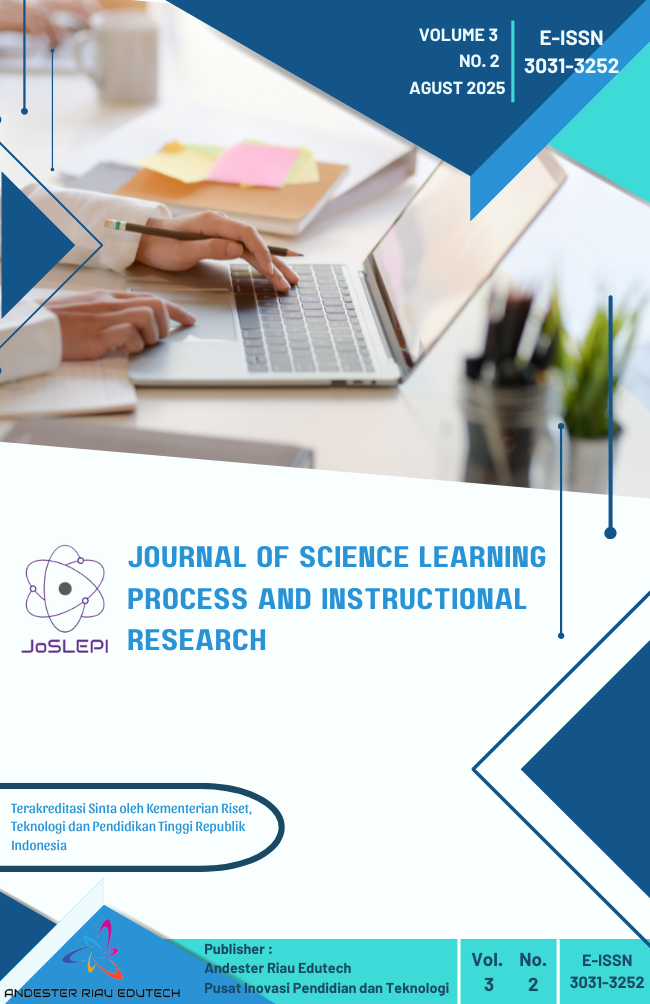Implementation Of The Read Answer Discuss Explain Create Learning Model To Improve The Cognitive Learning Outcomes Of Grade VIII Students On The Material Of Light and Optical Devices
Keywords:
Constructivism Learning, Cognitive Learning Outcomes, Light and Optical InstrumentsAbstract
This study aims to describe and analyze the cognitive learning outcomes of students by applying the Read, Answer, Discuss, Explain, and Create (RADEC) learning model on the topic of light and optical devices in grade VIII of SMPN 5 Pekanbaru. The population of this study consisted of all grade VIII students, spread across eight classes. To determine the sample, normality and homogeneity tests were conducted, followed by a simple random sampling technique, resulting in a total of 67 students selected as participants. The research employed a quasi-experimental design with a post-test control group design. The experimental group was taught using the RADEC model, while the control group used conventional learning methods. Data on students’ cognitive learning outcomes were obtained through post-test assessments and then analyzed statistically. The results revealed that the cognitive achievement of students in the experimental group reached an average score of 78, categorized as high. In contrast, the control group obtained an average score of 65.31, which was categorized as medium. Furthermore, hypothesis testing showed a significant difference between the two groups, indicating that the application of the RADEC learning model had a positive impact on students’ cognitive outcomes. The improvement in the experimental class is strongly attributed to the structured phases of RADEC, which encourage active student engagement. The phases of reading, answering, discussing, explaining, and creating allowed students to not only comprehend the material but also to communicate their understanding and apply it creatively. Such active involvement fostered deeper learning, critical thinking, and collaboration skills, which were less evident in the conventional class. In conclusion, the RADEC learning model is proven to be an effective strategy to enhance students’ cognitive learning outcomes in physics, especially on light and optical devices. This model can serve as an alternative instructional approach for teachers seeking to improve student achievement and engagement in science learning.
Downloads
References
Amaliyah, M. (2021). Journal of Science Education and Learning Analysis of Learning Difficulties and Factors Causing Science Learning Difficulties of Students of SMP Negeri 4 Singaraja development (OECD). Student abilities. Indonesian Journal of Science Education and Learning (JPPSI), 4(April), 90–101.
Azhar, A., Irawan, D., & Ramadhan, K. (2022). STEM Education Implementation to Enhance Student Learning Outcomes in Optics Concept. Journal of Science Education Research, 8(2), 1023–1029. https://doi.org/10.29303/jppipa.v8i2.1525
Fajria, S., Azhar, & Nasir, M. (2025). Application of Scientific Approach Assisted by Baamboozle to Improve Cognitive Learning Outcomes On Substance Pressure Material for Class VIII SMP. Journal of Science, Learning Process and Instructional Research, 3(1), 18–25. https://journal.riau-edutech.com/index.php/joslepi/article/view/99
Ikhsan, K. Z. Z. P. R. (2025). Implementation of a Simulation-Based Learning Model Using PHET to Improve Learning Outcomes for Class IX MTsN 1 Kuantan Singingi. Journal of Educational Sciences, 5(4), 715–723
Maryam, S., & Fatmawati, F. (2024). The Effect of the RADEC Learning Model on Student Learning Motivation in Advertising Materials, Slogans, Posters of Class VIII SMPN 2 Siak Kecil. Onoma Journal: Education, Language, and Literature, 10(1), 1052–1062. https://doi.org/10.30605/onoma.v10i1.3435
Permana, N. D., Lestari, I., Susanty Harahap, F. D., Azhar, A., & Defianti, A. (2023). Project Based Learning (PjBL) Model with STEAM Approach: Its Impact on Students Creative Thinking Skills on Energy in Living System Topic. Journal of Natural Science and Integration, 6(2), 186. https://doi.org/10.24014/jnsi.v6i2.25791
Pratama, Y. A., Sopandi, W., & Hidayah, Y. (2019). RADEC Learning Model (Read-Answer-Discuss-Explain And Create): The Importance of Building Critical Thinking Skills In Indonesian Context. International Journal for Educational and Vocational Studies, 1(2), 109–115. https://doi.org/10.29103/ijevs.v1i2.1379
Rizal, S., Usman, T., Azhar, A., & Puspita, Y. (2020). Improving the Quality of Education Through a Quality Assurance System. Didaktika: Journal of Education, 9(4), 469–475. https://doi.org/10.58230/27454312.152
Ruwaida, H. (2019). Cognitive Process in the Revised Bloom's Taxonomy: Analysis of the Ability to Create (C6) in Islamic Jurisprudence Learning at MI Miftahul Anwar, Banua Lawas Village. Al-Madrasah: Journal of Elementary Madrasah Education, 4(1), 51. https://doi.org/10.35931/am.v4i1.168
Susanto, M. Y., Mumpuni, A. D., & Fadhilah, I. N. (2019). Development of Rational and Objective Thinking Patterns in Science Learning through a Scientific Approach. School Culture Literacy Bulletin, 1(1), 12–18. https://doi.org/10.23917/blbs.v1i1.9302
Widyarti, O., Rokhmaniyah, R., & Suryandari, K. C. (2024). Application of the RADEC Model to Improve Elementary School Students' Creative Thinking Skills in Science Learning. Kalam Cendekia: Scientific Journal of Education, 12(1), 1–10. https://doi.org/10.20961/jkc.v12i1.75374
Downloads
Published
How to Cite
Issue
Section
License
Copyright (c) 2025 Ririn Andriani Ririn Andriani, Azhar, Muhammad Syafi'i

This work is licensed under a Creative Commons Attribution-ShareAlike 4.0 International License.













